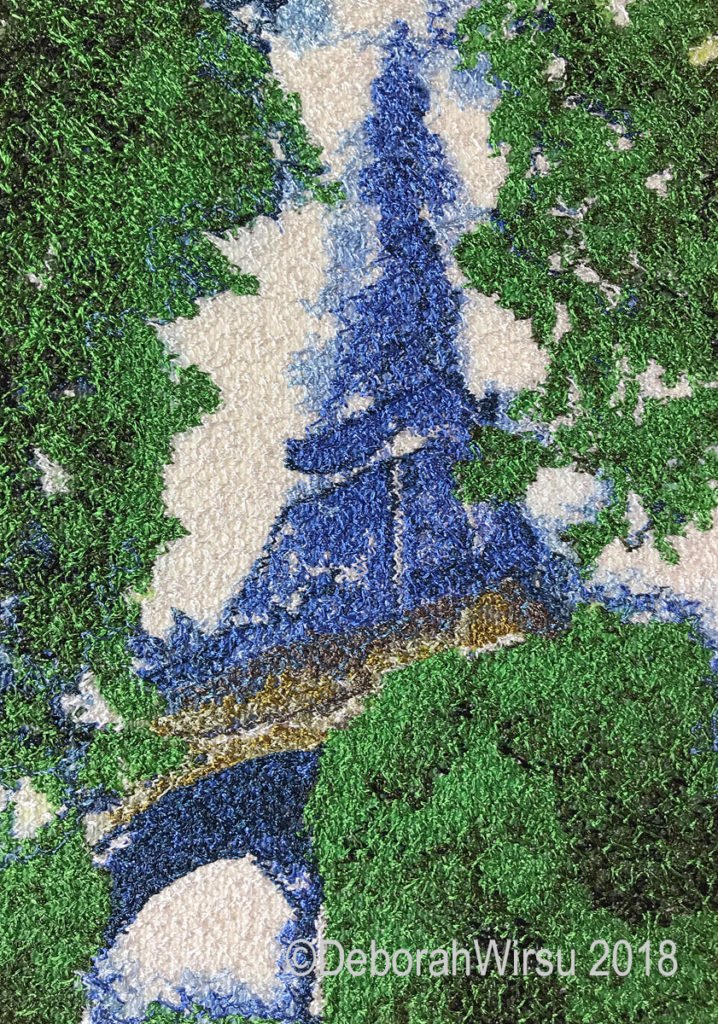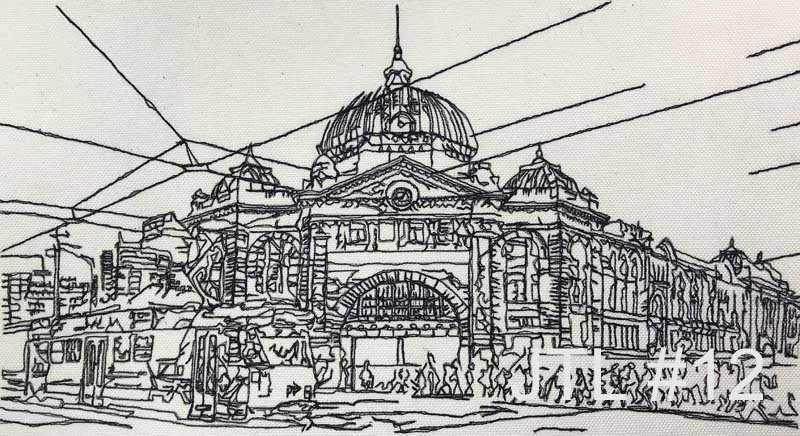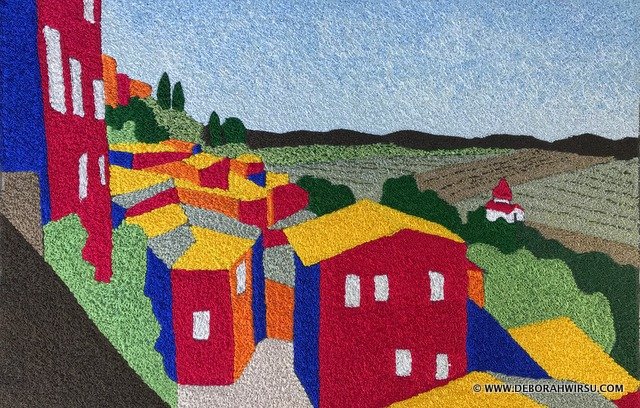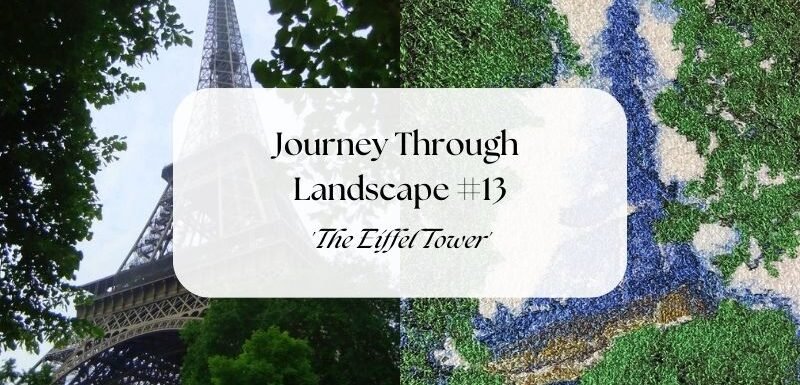
Thread painting landscapes offers a great way to create keepsake art pieces based on your travels.
Replace your brushes with your sewing machine!
When you love to travel and take photos and do thread sketching or thread painting, then you simply can’t go past tossing away the paintbrushes (especially if you’re a frustrated watercolourist or oil painter like me) and replace them with your sewing machine.
To create this latest Journey Through Landscape – #13 – The Eiffel Tower thread painting, I used a photo I took one summer in Paris, snapped from just clear of the base of the Eiffel Tower and a little behind the trees.
[Disclosure: Please expect that some (not all) hyperlinks on this site are affiliate links, which means I may receive a small commission (at no further expense to you) if you click through and purchase the product. This is one of the ways I support myself and continue to bring you free content and information. The decision about whether to buy a product or not is completely up to you.]
3 things you can learn from this thread painting
1. About Photography
While there are many ways to frame a shot when taking pictures, one of the fundamentals that will rarely let you down, is to make sure the subject of the picture is framed.
In the case of this image of the Eiffel Tower, the tower is framed by the trees on either side.
Even though I took this a few years ago, I clearly remember walking away from the tower and into the trees to achieve a composition I was happy with. Any of the pictures I took from up-close just didn’t have the look I was after.
Having said that, this iconic building presents hundreds of composition opportunities from the dramatic structural shot, to the more generalised landscape shot, as I have taken.
2. About Interpretation
Once again, so many choices in how to stitch this picture!
I considered taking the architectural approach, much as I did with my recent thread sketch of Flinders Street Railway Station here in Melbourne.

But since I was in Paris at the time, and my love for Impressionist art seems to permeate so much of my work, the Impressionist approach was the one I had to take.
With just a little manipulation and ‘blurring’ of the image, I was able to produce a workable base image from which to begin.
3. About Shading
Thread painting by machine presents very different opportunities and challenges to thread painting using hand embroidery or traditional needlepoint techniques.
Shading with needlepoint usually necessitates having many colours of thread, so that the effect of shading is created when the stitches are set side by side, as different coloured threads are not overlapped when working needlepoint.
However, when creating a similar look using free motion machine zigzag stitch, it’s possible to work with fewer colours and stitch over other colours in order to blend the shades, much as you would with liquid paint.
Looking at a detail of the stitching of the top of the tower in Journey Through Landscape #13 you can see that the edges of the structure have been blended into the sky itself.
I began with the darkest blue, to give the tower some strength and depth, then overstitched this with lighter blues, until I reached a shade that would merge well into the sky, creating a natural blend from structure to background.
Similarly, the trees are also worked with a range of different greens and blues and, here and there, merged into the background, too.
Using free motion zigzag stitch to work thread painted pictures offers so many opportunities for variety and approach. The difference between blending colours and using blocks of colour is strikingly demonstrated in this earlier work of mine. In this work, only the sky and some of the crop fields have been worked with blended shades.


I am middle of the road – between impressionistic and using blocks of color. I’d like to create more pieces that blend between the two. – Please keep up the good work you’ve done, Deborah. I so appreciate all you’ve done.
Hi Connie – you sound a bit like me! I can never decide what my favourite style is either – I think I just like moving from one to another, experimenting! And thank you for your kind comments … yes, I’ll keep going! Deborah
Sorry to hear you have been struggling lately with life, I find that using my creative juices helps me when I am down in the dumps. I would hope with all your talent in both music and art you could find joy there, also. Please keep up the beautiful work you are doing. As far as my style preferences, I have never been a fan of modern or impressionist styles I enjoy seeing nature captured in my art.
Hi Jo Beth – thank you for your response – everyone goes through problems from time to time. I’m not alone! And yes, the music and art do bring me great joy!
I find the work amazing, in that it does not look like stitches. It almost looks like carpet grass. I love the look. I polled as photo realistic, not sure if that’s what I meant.
I love your ‘carpet grass’ description, Lane! That’s not something I had thought of. I have likened it to ‘moss’ in the past, which I suppose has a similar look. Thanks for your response!
Hi Deborah, I am glad to hear that your music and art give you the joy that your work gives us. What would life be without it, so thank you for giving us alternative styles and ways to do it in. I love natural looking compositions and also love the more blurred softer lines of the impressionist approach. In saying that, it really depends on the subject matter, and I can certainly appreciate all the ways you have portrayed them in. You always inspire me and your Eiffel Tower has made me think of buildings from the Ming Dynasty. I am going to try and reproduce one of their wonderful temples, using the impressionist approach. If mine is half way as good as your Eiffel Tower, I will be very stoked indeed. Have a wonderful Christmas and my heartfelt blessings for an easier and healthy NewYear.
Hi Bobbie – Oh! I’m looking forward to seeing your Ming Dynasty buildings – fabulous subject matter for this style! You must show me (ppppleease!). Thanks for you comments, too. The poll results are showing a real cross-section of preferences so far. I’ll let everyone know when I have a good cross-section. I love to try to present my work using different styles, although it’s pretty obvious where my favourites lie! Have a lovely, safe Christmas and 2019!
Deborah
Hello,
Such a talent you are. At 83 I struggle at times. Thank the Lord still here. Love to read your words. Been FM many years, love it also. Just the touch of the threads and putting colors on a wonderful piece of material thrills me. Go get ’em girl. Keep the faith. Know your loved by all of us that follow you. Happy stitching.
Joyce, what a beautiful message – thank you 🙂
I am always gladdened when I hear of people like you who continue to enjoy doing the things that bring you joy, and it just could be one of the things that contributes to keeping you going, so don’t stop! Deborah (who has no plans to stop doing the things I love, either!)
Hi Deborah just to say I am glad to hear you are coming out the other side of whatever challenges you had to overcome in 2018.Wishing you brighter days ahead.You always seem so upbeat and motivational in your videos and you have certainly given me much joy and inspiration from your courses.I discovered thread painting accidentally many years ago when things had gone askew in my world.Since then it has been my go to form of relaxation and creativity..I love your Flinders Street thread sketch.My only son emigrated to Melbourne and we visited him some years ago so it brings back good memories.
Wishing you happy days ahead.
Nuala
Hi Nuala – thank you for your kind words. I’m moving on, and am so pleased I’ve been able to inspire you. And yes, I know what it’s like to have a son living overseas – mine was in London for quite a number of years, but is back here now. Take care!
I have watched many of your thread sketching videos. I took one of your thread sketching classes and found it very informative. I have learned a lot by watching you create. Self expression through art with thread and fabric keeps me happy. I want to try painting on fabric and then embellish the design with thread sketching. I am glad you will be creating again and sharing your work with your followers. I have taught several beginner free motion quilting classes at my local quilt shop. This Saturday I will be teaching a beginner thread sketching class using printed panels. I will give the students your name and website as a reference.
Hello Roberta – I’m so pleased you are using your skills to share with others in the classes – that’s wonderful. And many thanks for passing on my website details! I agree that self-expression in art (and other creative outlets) keeps many of us happy and is something we can share with the world.
Hi Deborah,
Thanks for the work you do and sharing it. I was wondering about the zigzag thread painting. What foot do you use? Or what stitch? I ask because a zigzag stitch does not fit in my darning foot.
I’d be interested to read more about that process.
Hi Claudia – zigzag can, indeed, be used for thread painting. I use free motion zigzag a lot, but a certain amount can also be achieved with regular or ‘non’ free motion, too. If doing free motion zigzag you need to use an open toe (C-shaped) free motion foot which has a wide-ish opening (enough for zigzag). Some darning feet have much smaller openings. Check with your machine supplier or local sewing/quilting/machine store to see if they can recommend a foot for your machine, or look online. I have a course which specifically covers thread sketching and thread painting with zigzag – ZIGZAG ZAZZLE. You can check it out here:
Class bundle (discounted) – https://learn.deborahwirsu.com/p/zigzag-zazzle-class-bundle
Part One – https://learn.deborahwirsu.com/p/zigzag-zazzle
Part Two – https://learn.deborahwirsu.com/p/zigzag-zazzle1